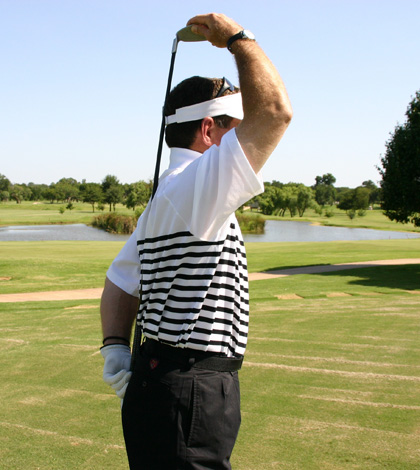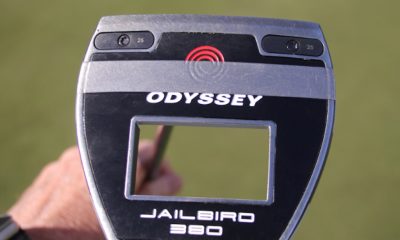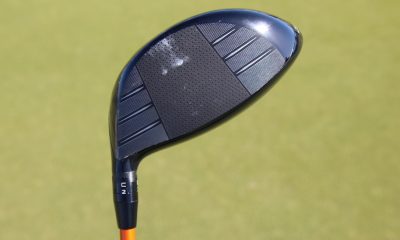Instruction
Improve Flexibility with these Stretches

During the past five years, I have come to realize that no matter how badly golfers over 50 years old need to work on golf flexibility and golf exercise, the vast majority just do not do it.
Everybody wants the benefits and I am always answering golfers questions on how to regain a youthful swing. But as soon as I steer the conversation to golf flexibility “training” or “exercise,” I see the eyes glaze over and the interactive conversation that we were just having turns into a one-way conversation with only a few distracted grunts in response.
This has been one of my greatest obstacles.
Key to Golf Flexibility For the Busy Golfer
I have found the key to winning the hearts of these golfers is to keep it super short and super simple. If you are a busy golfer, I have put together a 5-minute golf stretching and spine stabilizing program that can be completed in five or six minutes and can be performed anywhere.
Do Not Stretch Before Golf: Warm Up Instead!
If you have followed the most current research into athletic performance, you know that the long held belief that static stretching before activity is not only pointless but can lead to increased risk of injuries and decreased performance (static stretching being defined as holding a stretch for longer than seven seconds). Therefore, before you tee it up, it is key to warm up using a dynamic motion warm up to heat up the muscles. Static stretching before you play golf will put you at a greater risk of injury — don’t do it.
However, stretching any other time, and often, is vital for a great golf swing. Especially as you pass the age of 50.
Here is a simple and short program that will improve your golf flexibility, golf balance, performance, as well as decrease your risk of injury.
Golf Super Stretch Series
1. Golf Stretch One
Setup: Take long step forward with your right leg. Bend forward at the hips and keep your back flat.
Golf Action: Holding the ends of a golf club, rotate your body to the right until you feel a stretch.
Parameters: Hold stretch for 30 seconds and repeat stretch to the left with left leg forward.
Keys to Success: If you find it difficult to balance in this position, move your feet further to the sides for a wide stance.
2. Golf Stretch Two: This exercise is slightly tweaked to stretch your hamstrings as well.
Setup: Same as Stretch One
Golf Action: Rotate your body to the right as done in the previous stretch, but also straighten your knees and then bend forward at the waist until you feel a strong hamstring stretch and hold.
3. Golf Stretch Three: This exercise is slightly tweaked to stretch your glutes and hamstrings.
Setup: Take a long step forward with your right foot.
Golf Action: Rotate around your right leg as before. Bend as far forward at the hips as you are able, until you feel a stretch in your glutes (butt).
Key to Success: Try to keep your back flat when bending forward.
4. Golf Stretch Four: This exercise is slightly tweaked to improve spinal muscular mobility.
Setup: Take a large step forward with your right leg.
Golf Action: Rotate your body to the right. Then side bend to your right until you feel a stretch in your left side.
5. Golf Stretch Five: This exercise is slightly tweaked to maximize hip and spinal rotational mobility.
Setup: Take a large step forward with your right leg.
Golf Action: Rotate as far as you are able to the right. Allow your head to rotate to the right as well. Now try and rotate your arms even further, pushing back with your left hand and pulling back with your right hand.
There it is. Five stretches, 30 seconds to each side. Only 5 minutes out of the 1,440 minutes available to you every day.
*In stretches Nos. 1-4, do not allow your head to rotate with your body. Focus on a point just in front of you.
**Repeat all stretches with the left leg forward, rotating around to the left.
***To improve your core and spinal stabilization, hold more than one golf club. Try holding three golf clubs at the same time and you will feel it!
- LIKE8
- LEGIT0
- WOW0
- LOL1
- IDHT0
- FLOP0
- OB0
- SHANK0
Instruction
The Wedge Guy: The easiest-to-learn golf basic

My golf learning began with this simple fact – if you don’t have a fundamentally sound hold on the golf club, it is practically impossible for your body to execute a fundamentally sound golf swing. I’m still a big believer that the golf swing is much easier to execute if you begin with the proper hold on the club.
As you might imagine, I come into contact with hundreds of golfers of all skill levels. And it is very rare to see a good player with a bad hold on the golf club. There are some exceptions, for sure, but they are very few and very far between, and they typically have beat so many balls with their poor grip that they’ve found a way to work around it.
The reality of biophysics is that the body moves only in certain ways – and the particulars of the way you hold the golf club can totally prevent a sound swing motion that allows the club to release properly through the impact zone. The wonderful thing is that anyone can learn how to put a fundamentally sound hold on the golf club, and you can practice it anywhere your hands are not otherwise engaged, like watching TV or just sitting and relaxing.
Whether you prefer an overlap, interlock or full-finger (not baseball!) grip on the club, the same fundamentals apply. Here are the major grip faults I see most often, in the order of the frequency:
Mis-aligned hands
By this I mean that the palms of the two hands are not parallel to each other. Too many golfers have a weak left hand and strong right, or vice versa. The easiest way to learn how to hold the club with your palms aligned properly is to grip a plain wooden ruler or yardstick. It forces the hands to align properly and shows you how that feels. If you grip and re-grip a yardstick several times, then grip a club, you’ll see that the learning curve is almost immediate.
The position of the grip in the upper/left hand
I also observe many golfers who have the butt of the grip too far into the heel pad of the upper hand (the left hand for right-handed players). It’s amazing how much easier it is to release the club through the ball if even 1/4-1/2″ of the butt is beyond the left heel pad. Try this yourself to see what I mean. Swing the club freely with just your left hand and notice the difference in its release from when you hold it at the end of the grip, versus gripping down even a half inch.
To help you really understand how this works, go to the range and hit shots with your five-iron gripped down a full inch to make the club the same length as your seven-iron. You will probably see an amazing shot shape difference, and likely not see as much distance loss as you would expect.
Too much lower (right) hand on the club
It seems like almost all golfers of 8-10 handicap or higher have the club too far into the palm of the lower hand, because that feels “good” if you are trying to control the path of the clubhead to the ball. But the golf swing is not an effort to hit at the ball – it is a swing of the club. The proper hold on the club has the grip underneath the pad at the base of the fingers. This will likely feel “weak” to you — like you cannot control the club like that. EXACTLY. You should not be trying to control the club with your lower/master hand.
Gripping too tightly
Nearly all golfers hold the club too tightly, which tenses up the forearms and prevents a proper release of the club through impact. In order for the club to move back and through properly, you must feel that the club is controlled by the last three fingers of the upper hand, and the middle two fingers of the lower hand. If you engage your thumbs and forefingers in “holding” the club, the result will almost always be a grip that is too tight. Try this for yourself. Hold the club in your upper hand only, and squeeze firmly with just the last three fingers, with the forefinger and thumb off the club entirely. You have good control, but your forearms are not tense. Then begin to squeeze down with your thumb and forefinger and observe the tensing of the entire forearm. This is the way we are made, so the key to preventing tenseness in the arms is to hold the club very lightly with the “pinchers” — the thumbs and forefingers.
So, those are what I believe are the four fundamentals of a good grip. Anyone can learn them in their home or office very quickly. There is no easier way to improve your ball striking consistency and add distance than giving more attention to the way you hold the golf club.
More from the Wedge Guy
- The Wedge Guy: Golf mastery begins with your wedge game
- The Wedge Guy: Why golf is 20 times harder than brain surgery
- The Wedge Guy: Musings on the golf ball rollback
- LIKE83
- LEGIT13
- WOW5
- LOL1
- IDHT0
- FLOP4
- OB1
- SHANK8
Instruction
Clement: Stop ripping off your swing with this drill!

Not the dreaded headcover under the armpit drill! As if your body is defective and can’t function by itself! Have you seen how incredible the human machine is with all the incredible feats of agility all kinds of athletes are accomplishing? You think your body is so defective (the good Lord is laughing his head off at you) that it needs a headcover tucked under the armpit so you can swing like T-Rex?
- LIKE0
- LEGIT2
- WOW2
- LOL0
- IDHT0
- FLOP0
- OB0
- SHANK2
Instruction
How a towel can fix your golf swing

This is a classic drill that has been used for decades. However, the world of marketed training aids has grown so much during that time that this simple practice has been virtually forgotten. Because why teach people how to play golf using everyday items when you can create and sell a product that reinforces the same thing? Nevertheless, I am here to give you helpful advice without running to the nearest Edwin Watts or adding something to your Amazon cart.
For the “scoring clubs,” having a solid connection between the arms and body during the swing, especially through impact, is paramount to creating long-lasting consistency. And keeping that connection throughout the swing helps rotate the shoulders more to generate more power to help you hit it farther. So, how does this drill work, and what will your game benefit from it? Well, let’s get into it.
Setup
You can use this for basic chip shots up to complete swings. I use this with every club in my bag, up to a 9 or 8-iron. It’s natural to create incrementally more separation between the arms and body as you progress up the set. So doing this with a high iron or a wood is not recommended.
While you set up to hit a ball, simply tuck the towel underneath both armpits. The length of the towel will determine how tight it will be across your chest but don’t make it so loose that it gets in the way of your vision. After both sides are tucked, make some focused swings, keeping both arms firmly connected to the body during the backswing and follow through. (Note: It’s normal to lose connection on your lead arm during your finishing pose.) When you’re ready, put a ball in the way of those swings and get to work.

Get a Better Shoulder Turn
Many of us struggle to have proper shoulder rotation in our golf swing, especially during long layoffs. Making a swing that is all arms and no shoulders is a surefire way to have less control with wedges and less distance with full swings. Notice how I can get in a similar-looking position in both 60° wedge photos. However, one is weak and uncontrollable, while the other is strong and connected. One allows me to use my larger muscles to create my swing, and one doesn’t. The follow-through is another critical point where having a good connection, as well as solid shoulder rotation, is a must. This drill is great for those who tend to have a “chicken wing” form in their lead arm, which happens when it becomes separated from the body through impact.
In full swings, getting your shoulders to rotate in your golf swing is a great way to reinforce proper weight distribution. If your swing is all arms, it’s much harder to get your weight to naturally shift to the inside part of your trail foot in the backswing. Sure, you could make the mistake of “sliding” to get weight on your back foot, but that doesn’t fix the issue. You must turn into your trial leg to generate power. Additionally, look at the difference in separation between my hands and my head in the 8-iron examples. The green picture has more separation and has my hands lower. This will help me lessen my angle of attack and make it easier to hit the inside part of the golf ball, rather than the over-the-top move that the other picture produces.


Stay Better Connected in the Backswing
When you don’t keep everything in your upper body working as one, getting to a good spot at the top of your swing is very hard to do. It would take impeccable timing along with great hand-eye coordination to hit quality shots with any sort of regularity if the arms are working separately from the body.
Notice in the red pictures of both my 60-degree wedge and 8-iron how high my hands are and the fact you can clearly see my shoulder through the gap in my arms. That has happened because the right arm, just above my elbow, has become totally disconnected from my body. That separation causes me to lift my hands as well as lose some of the extension in my left arm. This has been corrected in the green pictures by using this drill to reinforce that connection. It will also make you focus on keeping the lead arm close to your body as well. Because the moment either one loses that relationship, the towel falls.


Conclusion
I have been diligent this year in finding a few drills that target some of the issues that plague my golf game; either by simply forgetting fundamental things or by coming to terms with the faults that have bitten me my whole career. I have found that having a few drills to fall back on to reinforce certain feelings helps me find my game a little easier, and the “towel drill” is most definitely one of them.
- LIKE12
- LEGIT2
- WOW2
- LOL0
- IDHT0
- FLOP2
- OB0
- SHANK8
-

 19th Hole2 weeks ago
19th Hole2 weeks agoJohn Daly stuns fans into silence with brutal opening tee shot on PGA Tour Champions
-

 19th Hole1 week ago
19th Hole1 week agoThings got heated at the Houston Open between Tony Finau and Alejandro Tosti. Here’s why
-

 19th Hole5 days ago
19th Hole5 days agoReport: Tiger Woods has ‘eliminated sex’ in preparation for the 2024 Masters
-

 19th Hole3 weeks ago
19th Hole3 weeks ago2-time major champ announces shock retirement from the sport at age of 33
-

 19th Hole3 weeks ago
19th Hole3 weeks agoEdoardo Molinari reveals the latest PGA Tour golfer to turn down ‘good offer’ from LIV Golf
-

 19th Hole2 weeks ago
19th Hole2 weeks agoCharlie Woods finds it tough going on American Junior Golf Association debut
-

 19th Hole1 week ago
19th Hole1 week agoAddiction, spinal fusion, and scam artists – Everything Anthony Kim revealed in candid interview with David Feherty
-

 19th Hole4 days ago
19th Hole4 days agoAnthony Kim says doctors told him that he ‘may not have much time left’ ahead of LIV return
























naflack
May 3, 2013 at 3:58 pm
I have participated in many stretching programs over the last ten years and can say with confidence that stretching has never done anything for me but cause pain and subsequent stiffness.
I have even gone so far as to see my doctor about this, he simply responded that anything that causes more stiffness will lead to more injury and that this is more common than people think. He continued that stretching is generally a good idea but isn’t for everyone. If others have had my experience it makes sense that so many gloss over in regards to stretching.
Ryan York
May 11, 2013 at 12:03 am
Naflack,
I am sorry to here you are having pain. Without seeing you myself, it is impossible to tell you exactly why you are having pain. However, I am irritated that your doctor did not pursue the issue further. Primary doctors are woefully undertrained when it comes to orthopedics. I would see an Orthopedic specialist, or you could see a physical therapist.
It could be a variety of issues. I am guessing that since you have been stretching for a while that your technique is not an issue and you don’t stretch to hard. Other issues would be arthritis but I would be concerned with vascular (blood flow) issues, maybe even nerve mobility restrictions.
Like I said, its hard to tell without seeing you an I am essentially guessing. I would really encourage you to see a good, orthopedic physical therapist. Preferable one that is a certified orthopedic specialist with and “OCS” credential.
Sorry I can’t offer you more but I would take it seriously and get checked out.
Dr. Ryan York, DPT CGS
Doctor of Physical Therapy
Certified Golf Performance Specialist
Age Defying Golf
Jack Cox
Apr 29, 2013 at 2:31 pm
I enjoyed reading about the stretching routine. Myself being 60 years old doesn’t get to the gym alot anymore so some simple routines like these should help my game..Thank you